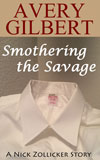
I recently had the opportunity to tour a licensed, commercial cannabis grow operation in Denver. It was a mind-blowing experience, but not for the obvious reason—I haven’t tried marijuana since an unfortunate episode in graduate school. [
A story, like that of the giant rat of Sumatra, for which the world is not yet prepared.—Ed.]
The operation is located in a nondescript, unlabeled building in the semi-industrial outskirts south of town. One step inside and there is no doubt where you are—the scent of cannabis bud hits you full in the face. That’s because the drying room is next to the entrance. Newly harvested and trimmed buds are spread on wire mesh frames, which are slotted into wall racks. The drying room is kept dark and air conditioned, while fans circulate the chilly air. This struck me as a counterintuitive way to dry the product, but Gary, the slim, thirty-something Willy Wonka who runs the site, tells me the aim is to suppress mold growth.*
As I sign in and get my visitor’s badge, I notice the wall of the entryway—it’s covered with a dozen or more framed certificates from the army of agencies that regulate every aspect of commercial cannabis in the state of Colorado: health, revenue, environmental, etc.
A couple of doors down is a small break room. With a refrigerator and cute sign reminding people to clean up after themselves, it could be the lunch area of a muffler shop or book store—except for the three HD screens on one wall. Each screen displays multiple views from security cameras mounted everywhere in the building, inside and out. Security is a major concern and private patrols visit the facility throughout the night.
The actual process of cultivation begins with small, two- or three-branch cuttings from mature plants. Like straws in soda cup lid, they are stuck into fittings atop a plastic tub. Inside the tub an “aquaponics” system periodically sprays the bottom of the clippings; the water contains carefully calibrated amounts of nutrients to encourage root growth. Once the sproutlings have developed enough of a root system, they are transferred to quart-size plastic bags of potting soil. Then they are given a unique, bar-coded, plastic ID tag purchased from a state-authorized provider. Individual plants are tracked this way until harvest—part of the minute oversight of inventory required by Colorado authorities.
In their quart bags, the new plants resemble the immature tomato plants for sale at Safeway. Arranged in neat rows on white platforms, they begin to bask under a glaring array of artificial lights that keeps the room as warm as the greenhouse it is. The room air is humid but odorless.
After a week or two, the now established plants are transferred to three- or five-gallon bags and moved to a “vegetative room” where they get 18 hours of light daily from high output T5 fluorescent bulbs. They are watered via an automated drip tube system. The room air is kept moving by wall-mounted oscillating fans. Here, again, the room is relatively nonodorous.
Once they are mature, the plants are transferred to a “bloom room.” Individual stalks are woven through a loose rope grid that separates the tops and insures that each newly forming flower bud gets maximal exposure to light. Beside the usual automatic lighting and watering system (now delivering a nutrient mix optimized to encourage bud growth), the bloom room is supplied with extra carbon dioxide. It is delivered (during “daytime” only) via an automated system that monitors the ambient concentration and keeps it at a specific parts per million level. On the bloom room door is posted a sign: “You are entering a possibly oxygen deficient atmosphere.” Should the CO
2 level exceed the safety threshold, a warning light flashes and an alarm sounds. It’s an expensive system, but it’s required by the state. “Seems reasonable,” I say to Gary, who shrugs his shoulders. He operates under an OSHA rule that specifies one permissible level for CO
2 and under a Colorado marijuana-specific rule that specifies a different, lower level.
In the bloom room, I notice for the first time a distinct background odor—it smells like ripe, even overripe, cantaloupe melon. Nothing at all like the funky herbal smell of dry bud. Yet in order to minimize the risk of complaints from neighbors, Gary has installed large, cylindrical carbon filter units in each bloom room. Harvest day, he says, produces the greatest amount of smell, presumably from the volatile and odorous terpenes that are released as the plants are cut.
The previous tenant of this building was a light-industrial operation. When the marijuana company took over the building it completely renovated the interior. The array of active technologies—lights, fans, watering systems, CO
2 delivery, air filtration, HVAC—requires an enormous amount of power. Multiple electrical conduits and air conditioning ducts course along the ceiling and curve down to individual grow rooms—it’s like being inside a gigantic pipe organ. Gary is on personal terms with his Carrier air conditioner rep who makes weekly visits to keep the system tuned up.
Gary keeps 70 different cannabis strains in rotation. From a manufacturing and logistics point of view this is an insane number. But the dispensaries he supplies—and their retail customers—demand it. If he delivers only 10 varieties they complain. What drives this demand? Besides sheer THC potency there are real and/or perceived psychotropic differences between
sativa and
indica strains, as well as differences in bud aroma and smoke flavor. And thus separate calls for OG Kush, Girl Scout Cookies, Strawberry Cough, Alaskan Thunder Fuck, and all the rest.
Having lived for a year now in Colorado, I’m beginning to see the connection with another artisanal, sensory- and botanical-based industry: beer. There are a ton of microbreweries in the state, and each one produces a range from stouts to IPAs. A microbrewery that produced only two or three beers would soon fail. People revel in sensory choice. And if they are accustomed to getting it in one area, they expect it in others.
This leads me to propose
Gilbert’s First Conjecture of Sensory Marketing:
For a given zip code, the number of microbrews on tap is positively correlated with the number of cannabis strains available in dispensaries.
Besides the usual burdens of running a business—hiring, scheduling, payroll, accounting—Gary has the responsibilities of a vintner. He decides when the plants are ready to harvest: too soon and they lack potency, too late and they become stale with oxidized THC. He has to plan the rotations of each strain, and stagger their growing cycles so he can harvest one of his eight bloom rooms each week. Then there is the matter of drying and curing. Gary does this the old school way, in two steps. From the racks in the drying room the buds go into large glass jars, equipped with humidity sensors, where they stay for another week or so, until they reach their optimum in terms of aroma and smokability. I suspect cigar makers and aficionados would agree. I sniff from several jars to get an idea of the range of strain-specific aromas. Some are not very smelly; in others I detect mint, a conifer note, and the vegetal scent of cooked artichoke. Elsewhere I’ve smelled buds that reeked of orange peel. There’s a lot of opportunity here for systematic olfactory evaluation.

With demand far outstripping supply, commercial cannabis growers are under enormous pressure to deliver mass quantities. To speed things up, some growers claim to use techniques that telescope drying and curing into a single step. Not Gary. However, he does make some concessions to efficiency. Instead of having employees trim buds by hand, he puts the buds into a tumbler-like device, an automated Edward Scissorhands. The broken leaf residue or “trim” doesn’t go to waste. (It can’t—the state requires that he account for every gram of it.) Gary’s operation, like others, sells the trim to extractors who transform it into oil, shatter, and the multitude of derivative products that are sold directly to consumers or that go into products such as edibles.
I have toured essential oil extraction operations in Grasse, fragrance compounding factories in New Jersey, a Budweiser brewery in Colorado, and numerous wineries and champagne makers in California. They all manage to bring industrial scale to what is, at its core, a process of subjective, sensory-based, aesthetic design. The Denver grow house, with its blend of technology, agronomy, and logistics, tells me that cannabis is on the road to similar scale.
*If Gary is the Willy Wonka, the Oompa-Loompas of the factory bear an uncanny resemblance (minus tattoos and piercings) to certain of my Berkeley Coop housemates of the 1970s.























